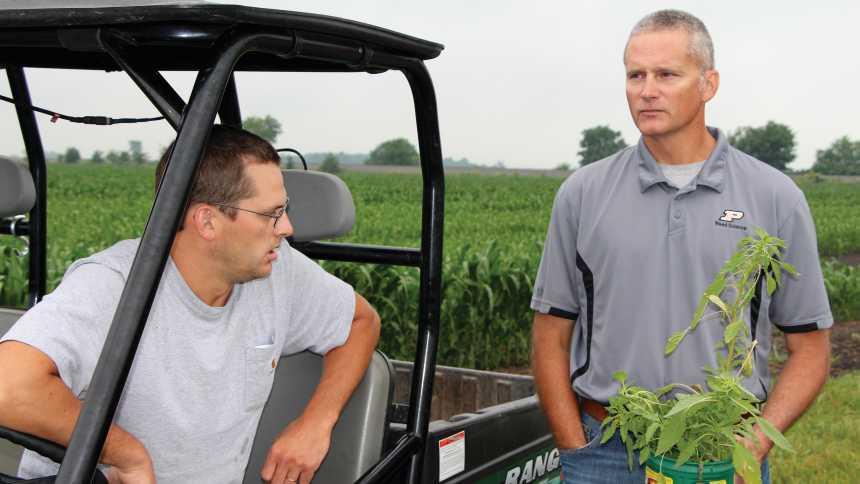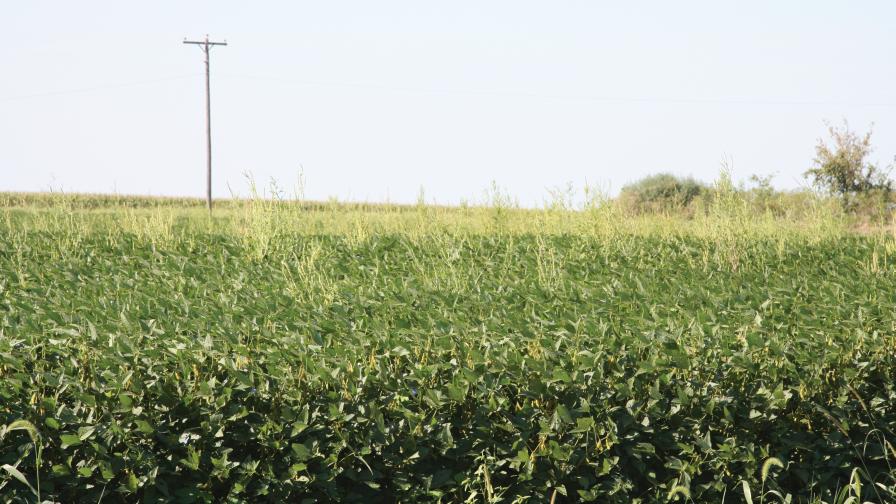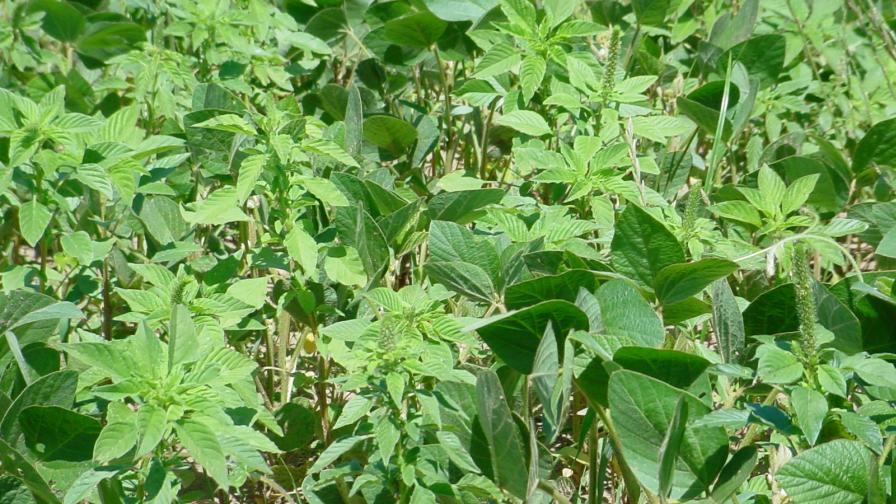Dicamba Weed Control Slips: What It Means for Growers, Retailers
While dicamba’s registration officially expires this December 20, a decision from EPA is expected perhaps months sooner in order to allow growers time to make planting decisions for next season.

Purdue University’s Dr. Bill Johnson with pigweed plant.
Dr. Bill Johnson, Professor of Weed Science at Purdue University, believes that regulators will not renew the label for the current formulations for XtendiMax, Engenia, and FeXapan vacated by the Ninth Circuit Court in June. However, he expects that new drift-reducing formulations submitted to EPA — details of which remain under wraps by the manufacturers — will successfully be registered and available for use next season.
Nevertheless, the potential for dicamba drift injury on top of spreading weed resistance are still likely to continue to pose a threat, leading growers and retailers to keep alternatives top of mind.
Asked about his thoughts on the future of the embattled herbicide, Grant Strom, who farms 5,600 acres of corn, soybean, and grain in Dahinda, IL, commented: “My biggest concern is not so much that I want to use dicamba. I’m fine using the (Corteva AgriScience) Enlist program over the top, but seed availability and genetic potential in the Enlist program as a whole is not as good as it is in the Xtend program.”
“If there’s a sudden switch to E3 or Liberty, there’s just not enough quality seed and quality genetics to go around to satisfy the market. That’s a big problem,” Strom said. “People have got to be willing to be give up yield to force themselves into a different herbicide program.”
In Tennessee, Weed Scientist Dr. Larry Steckel has documented dicamba-resistant Palmer amaranth populations in at least five counties, and there are likely more. He fielded calls throughout the 2020 season from growers “frustrated with goosegrass, junglerice, and Palmer amaranth escapes after a dicamba and glyphosate application,” he wrote in a University of Tennessee Institute of Agriculture (UT) blog post in July.
Those Palmer escapes from the initial dicamba application ranged from “a few scattered pigweeds across a field to a heavy carpet.” Steckel called the level of dicamba resistance relatively low, about 2.5 times. As such, even if the follow-up dicamba application was applied within seven days, “control would still likely be sketchy. It has no chance after 14 days.”
According to Steckel, the grass control issues can only be solved with an application of clethodim applied at least five days after the dicamba and glyphosate application. Clethodim applied within three days of a dicamba application will still typically provide poor grass control due to dicamba still effecting herbicide translocation throughout the grass, he noted.
“So, is it time to panic? No. However, it is time to reassess weed management,” Steckel wrote on his UT blog. He noted that looking forward to 2021, a pre-applied residual that is effective on Palmer is now a necessity. Moreover, timely applications of Liberty must be used shortly after a dicamba application to remove escapes. “Herbicide stewardship is now more important than ever.”

A Midwest field infested with waterhemp.
In Indiana, Johnson said calls have escalated this year about dicamba not working as well on controlling waterhemp, although he has received fewer calls than a year ago complaining about its efficacy on marestail.
Johnson acknowledged that spraying too-large weeds is a perennial problem, but resistance is also inevitable with dicamba now being sprayed on both sides of a corn and soy rotation in the state.
“It stands to reason that we’re selecting the resistant biotypes by continuing to spray dicamba,” he said, adding that growers continue to seek out alternatives, including Enlist. Adoption of that technology in the eastern Corn Belt, he noted, soared from around 5% in 2019 to between 25% and 30% in 2020.
“At one point this past winter, they couldn’t put (E3) seed fast enough in the bag. Growers are really interested; they’re frustrated with the negative publicity around dicamba, and they’re looking to do something a little bit different.”
Liberty, 2,4-D Control Issues
Tom Barber, University of Arkansas Extension Weed Scientist, discussed with CropLife® the concerning levels of postemergence control of pigweed that consultants and growers with whom he has been in contact are seeing in all technologies, but especially with Liberty (glufosinate).
Second or third applications that worked well on survivors in the past are now not doing the trick all the time, he said. Environmental and growing conditions, and the size of the pigweed at the time of application are largely to blame.
“After walking fields last week and visiting with Larry Steckel this week, it is evident that we are about to run out of chemical options for pigweed control in the north (Mississippi) Delta region. Growers should take all precautions necessary in suspect fields to remove these populations prior to seed production,” Barber said.
“When I evaluate my cotton and soybean weed control plots at Marianna (Arkansas) I have noticed that 22 ounce Xtendimax in Xtend or 32 ounce of Enlist One in Enlist are not controlling the populations of pigweed as well as they have in the past,” Barber added. “Two applications of either of these products generally controls most pigweed plants in my plots, but many times some survive. Likewise, two applications of 32 ounce per acre Liberty is required on small pigweed to have equal control.”
Dr. Jason Norsworthy, Professor of Crop, Soil, and Environmental Sciences at the University of Arkansas, has also observed reduced activity with glufosinate in the greenhouse on a pigweed population collected recently from one northeast Arkansas county. His results further indicate that additional populations collected are also showing signs of increased tolerance to dicamba and 2,4-D — in other words, if a pigweed population displays increased tolerance to dicamba, it also shows increased tolerance to 2,4-D.
On Palmer amaranth, Steckel found that 2,4-D-based Enlist One with glyphosate do not always provide effective control. Adding Liberty to an Enlist One tank-mix, he said, is the most consistent way to control the weed in Enlist crops. It should be noted that Liberty tolerance in Tennessee has not (yet) been found.
Over the last several seasons, Barber’s message has been to incorporate cultural systems into herbicide programs to help take pressure off herbicides, which often takes a mindset shift on the part of the grower, in addition to willingness to spend more time and money. Some of these include cover crops, narrow row spacing in order to get canopy earlier, and zero-tolerance approaches by not allowing pigweed to go back to the seed bank — not only in the field but around turn rows, ditches, and equipment yards.
University of Arkansas Extension also has made a large effort into researching weed seed destruction at harvest, along with techniques like narrow window burning and chaff lining.
“We’re looking at as many alternative methods to chemicals that we can find that reduce pigweed populations or break the numbers up that we have to deal with in-season,” Barber said.







